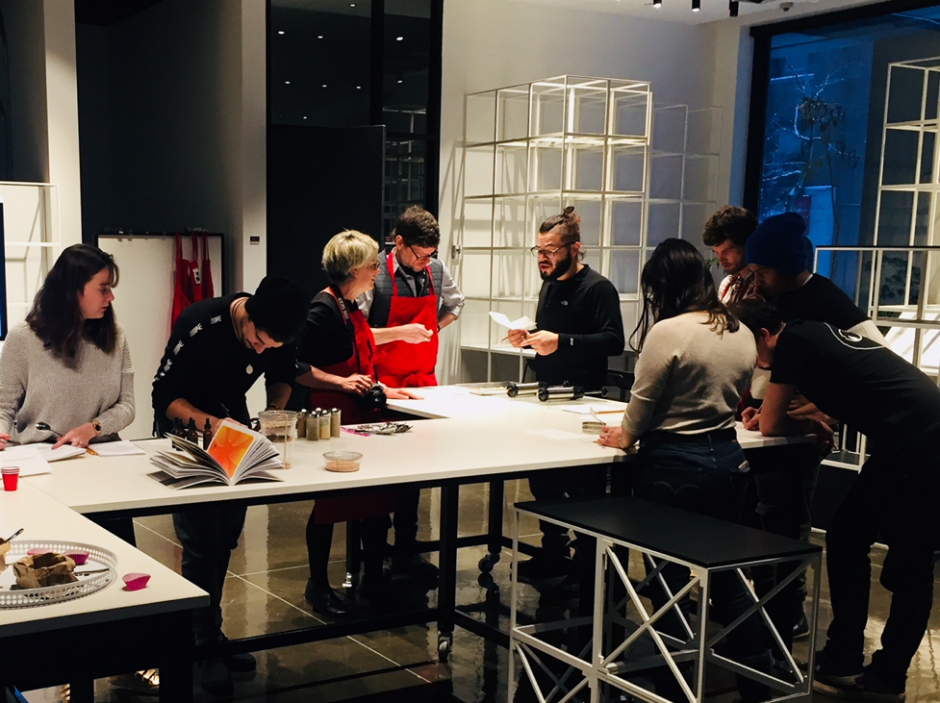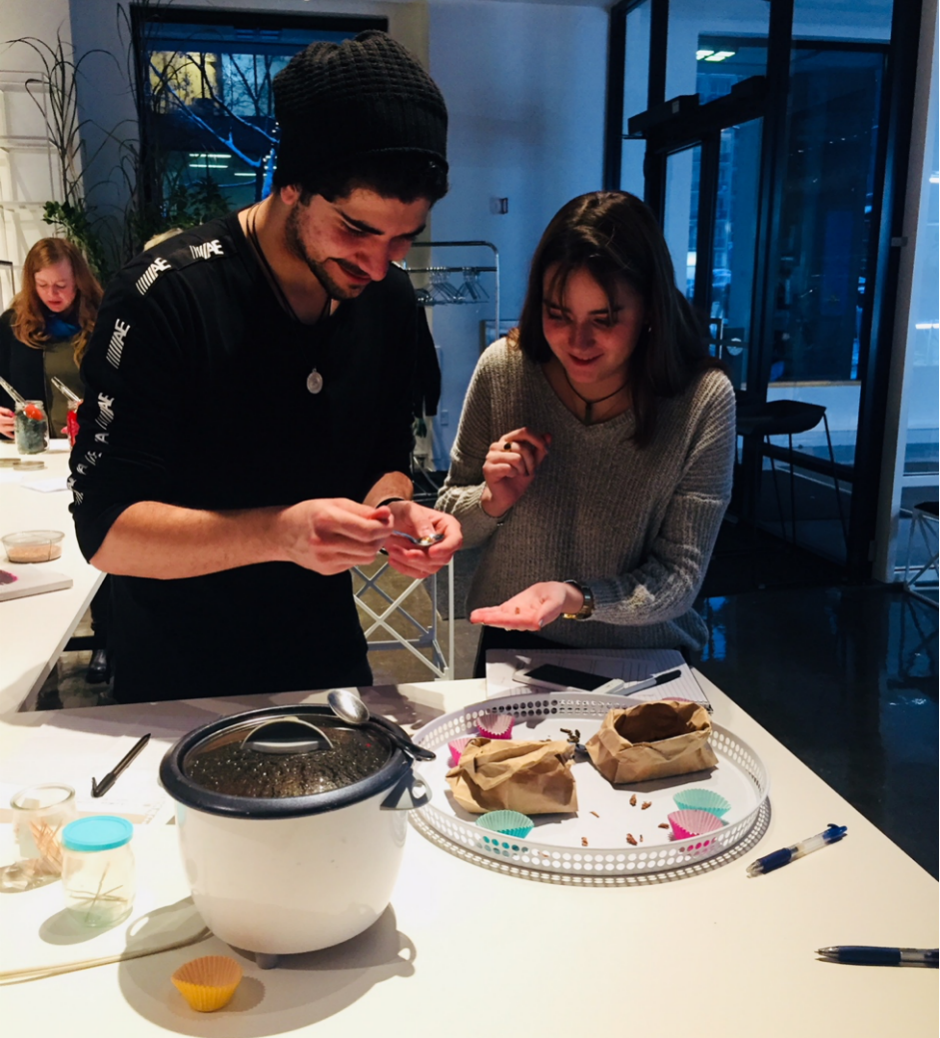Laura Shine is a doctoral candidate in Concordia’s Humanities program, in the fields of food anthropology, food marketing and sensory studies. She investigates the changes in attitudes and behaviours towards novel foods, with a particular focus on entomophagy. She has served as strategic consultant on the board of insect start-ups and presented talks and workshops on eating bugs in schools and university settings. In 2017, she devised and taught an undergraduate course in Food and Culture in Concordia’s Department of Sociology and Anthropology. Her research has been supported by scholarships from the SSHRC and the FQRSC, and by a fellowship from the Luc Beauregard Centre of Excellence in Communications Research.
Blog post
Sensing edibility

Salty jujubes? Horsemeat balls? Baby formula? Mystery powders and drops?
These were some of the goodies on offer at a recent workshop on edibility in Concordia’s spanking new 4TH Space, dedicated to showcasing cutting-edge research in an immersive and engaging environment. Their first event, which ran until November 23, was all about food.
Along with artist, researcher and PhD David Szanto, I organized a tasting to make attendees question their thoughts on edibility. In five distinct stations, visitors were invited to sample, discuss and think about the challenging foods on offer. Here’s a virtual tour of the bits and bites. How would you have reacted?
Lab whiz demo
In this station, eaters were presented with two orange/brownish pastes, extruded from large syringe-like tubes and served together on a paper-like wafer. Both pastes were riffs on preservation.
The first paste was made with fermented ingredients, one of humankind’s oldest techniques for food processing. It contained sourdough bread, artisanal cheese, traditional Thai fish sauce (nam pla) and naturally fermented hot sauce.
Many of our favourite foods today are products of fermentation: bread, cheese, alcohol, cured meats, soy sauce and yogurt, along with a host of vegetable-based ferments from all around the world such as kimchi, sauerkraut, kosher dills pickles and thousands more.
The varied techniques and microorganisms involved in each of these have helped us keep foods from times of abundance to times of scarcity, have offered a variety of delicious tastes and textures absent from fresh ingredients (think of wine vs. grapes, for instance, or bread vs. wheat), have enhanced our overall health and have fostered a host of human communities in all cultures of the world.
The second paste contained industrially preserved equivalents: white sliced bread, processed orange cheese, Worcestershire sauce and an industrial hot sauce. Industrial preservation, achieved through means such as preservatives, stabilizing agents and packaging techniques (canning, sous-vide and so on) defines much of the foods we consume today. It has allowed foods to have longer shelf lives, better transportability and standardized flavours and textures — a tub of Cheeze Whiz always tastes the same as the previous one.
To some, this is an advantage; to others, it’s an aberration. Nutritionally speaking, industrial foods are often less nutritious than fresh or naturally fermented ones, as excessive processing leads to a loss of nutrients (which are sometimes added back in later, as is the case for enriched white flour, for instance).
The juxtaposed pastes invited eaters to think about industrial vs. artisanal preservation methods and their results, but also about how much they really know about the foods they eat — what ingredients are in them exactly? Who made them and how? What process have they gone through and how has this affected them?
Sea of tranquiety
At the crossroads between tranquility and anxiety, two types of candy-like items were on offer here. Moonrock, a beautiful turquoise-blue tire-éponge, intrigued eaters and surprised them with a dose of peppery heat. Ocean gels looked more innocuous — red, jujube-shaped, with a bouncy texture. Once in the mouth, though, they delivered an overwhelming saltiness, a menthol cold and an almost crunchy gelatinousness typical of agar-stabilized gels.
Instead of dissolving as candy might, they presented a chewing challenge and a quasi-impossibility of ingestion due to the salt levels. As one eater described it, the gels produced a sensation akin to choking on seawater — a unexpected briny, invasive, cold shot.
One very frequent reaction to the ocean gels was hilarity, a response not often associated to food. Many attendees commented on the interesting experience of bursting into full-on laughter as they were shocked and overwhelmed. Expectations and experience brutally and noisily collided, leading tasters to reflect on the way our senses shape our expectations, sometimes deceiving us and leading to unforeseen reactions.
What do we anticipate when we approach a food? How do our senses — smell, sight, touch — suggest what might happen when we take a bite, and how much credence do we accord them? What happens when these anticipations are not met, and is there room for play in the gap between expectations and experience?
Feeding friend Z
Who do we trust to feed us and how close are we willing to let them get?
In this station, attendees were asked to prepare a “recipe” of their own creation with a variety of powders and liquids in small opaque bottles, to be combined in a spoon. Each product was identified, but the name did not refer to any recognizable item (though all were food products). Once the mix was ready, it was offered to another guest, ideally inserted directly into their mouth.
This process challenged tasters to think about trust in and reliance on the food preparation process. It physically engaged strangers — or sometimes friends — in an extremely intimate act reminiscent of childhood and redolent of dependence: that of being fed by someone else, especially a food that is unknown.
Formulating foods
In this station, eaters were given two small samples of baby formula and asked to fill in some tasting notes. Formula is meant to completely fulfill babies’ nutritional needs, as a replacement for human breast milk. For the first months of their lives, newborns only consume milk; according to current recommendations, it should remain their main food for the first year of life, supplemented by solid foods from the age of six months or so.
Milk is thus a foundational food, not only from a nutrition standpoint, but also from a taste-shaping perspective; as the first thing that enters babies’ mouths, it becomes a benchmark of taste. While breast milk changes daily according to the mother’s food intake, formula remains ever the same.
A savant mix of 30 or so ingredients, meant to cover babies’ dozens of micro- and macronutrient needs, it is formulated first and foremost with nutrition in mind, rather than taste, deliciousness or even palatability. It is far from being bland, however, since additives generally have strong off-putting flavours that need to be concealed. As tasters discovered, all formula brands are not equally formulated.
Nestlé® Good Start® was found to have "no smell," the "smell of a female body," "milky," "rich," "almost like vanilla" aromas. To some, it tasted "metallic and slightly bitter," "powdery," "sweet," "processed," with a "fatty," "watery," "waxy" finish. Overall, "not bad" for most, and "gag" for a few.
Hypoallergenic Similac® Alimentum® was another story altogether. Tasters described a "pungent," "Corn Flakes," "protein," "socks and shit," "sour," "BBQ," "plastic" nose. The taste was largely decried as "horrible," "dreadful," "terrible," "slimy," reminiscent of "saliva," "salty broth" and "bad milk," with a "very bitter," "strong," "persistent," "metallic," "rubbery" aftertaste. Overall, in the words of one taster, "deadly."
This comparative experience invited attendees to reflect on the nutritionist paradigm, which tends to place nutrition above all other concerns in regards to food. What do we consider primordial when edibility is at play? What lies beyond nutrition? How does the obsession with individual nutrients inform and transform sensory appreciation and how does it shape tastes?

The many meanings of meat
Why do we consume certain animals and shun others? Why do we eat cow and pig, but not wolf or muskrat? Why do we avoid insects, but accept shrimp and escargot?
In this station, tasters were presented with two kinds of insects — plain roasted crickets and salted, seasoned grasshoppers — and with horsemeat balls. Reactions to each proposition were varied. Some were interested in the insects’ nutritional value, others in the novelty factor. Surprisingly few refused to try them; instead, most found them delicious, especially the seasoned grasshoppers, which had many tasters asking for seconds.
The horsemeat was also met with mixed feelings. A few eaters had tasted horsemeat before, and felt it was little different from beef. Others were bewildered, for ethical or emotional reasons. One man was “brought up with horses” and could not imagine eating a companion.
Another attendee readily tasted but was assailed with unexpected visions of horses; while eating other meats did not evoke the animals they came from, she was surprised that she could think of nothing else but horses while she was chewing on their meat.
Food choices, and meat choices especially, are highly culture-dependant. Which animals we eat, avoid, or keep as pets varies, as do our willingness to use and consume them.
Though many eaters from European-derived cultures tend to consider insects as dirty and outside the realm of the edible, that is not the case for the 2 billion humans who consume them readily. This does not mean, however, that those we consider "insect–eaters" will eat any insect, prepared in any way.
As is the case for all human foods, cultural imperatives delineate how insects are chosen, harvested, prepared and consumed. Think of it this way: though we eat cow and pig, we would not imagine ourselves as “mammal-eaters.” In this regard, horse, much like kangaroo for instance, is a liminal substance laden with emotional significance. Other animals, such as fox or racoon, are largely shunned — not to mention cats and dogs.
Similarly, those who consume palm weevil larvae might be disgusted by the idea of chewing on crickets or lake flies, much like caterpillar-eaters might reject mealworms. Our "Western" grouping of insects into linean taxonomies (three body segments, six legs), or even lay categorization (“bugs,” including spiders, worms and such) do not adequately render the complexities of insect eating across cultures, or the care with which these foods are prepared for human consumption.
Questioning how and why we categorize animals and establish distinction within categories reveals a lot about where we set the boundaries of edibility. Presenting attendees with comestible, though often shunned, animals invited them to think through their ideas about acceptable meats.
Even if you missed the event, I invite you to (re)consider your ideas about what is edible and what is not, and to use these examples as a starting point to reflect on and discuss your food choices with others, perhaps even hold a challenging tasting of your very own concoction. Happy eating!
About the author
